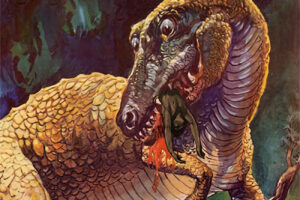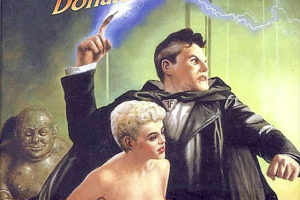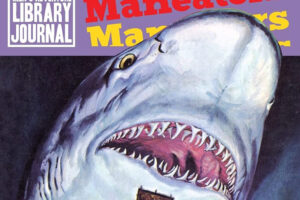
During the “classic” period of science-fiction, a popular sub-genre was the “space opera.” These stories were usually melodramas of epic heroes and villains who fought each other in outer space, usually across planets, solar systems, and sometimes galaxies, and with various advanced technologies. The science was often ignored for various unexplained faster-than-light space drives, ray guns, and other super technology.
Probably the most well-known writer of the space opera and its so-called father was E.E. (Edward Elmer) “Doc” Smith, Ph.D. (1890-1965). Yes, he had a real Ph.D. He was a food engineer, specializing in doughnut and pastry mixes.
During his career he wrote many science fiction works, but the most well-known are the Skylark and Lensman series. While none of his works appear to be in print, it looks like most are available in ebook formats.
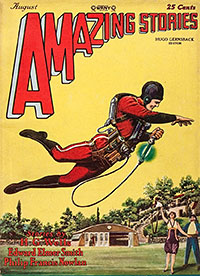
The Skylark series:
- “The Skylark of Space” (Amazing Stories, 1928, with Mrs. Lee Hawkins Garby)
- “Skylark Three” (Amazing Stories, 1930)
- “Skylark of Valeron” (Astounding Stories, 1934-35)
- “Skylark DuQuesne” (1965)
The Skylark series focuses on a small group of people. The first are two couples: a scientist (Seaton) and his best friend (Crane) and their girlfriends (they will later get married). The scientist designs and builds a spaceship that takes them to distant planets. They must contend with a larger-than-life villain (DuQuesne, pronounced “dukane”), who is a rival scientist who builds his own spaceship. The Skylark is the name of Seaton’s spaceship.
The good guys find alien races, and team up with them against the villain and his alien allies, which often turns into open conflict with even more powerful spacecraft and weapons designed and built by Seaton and DuQuesne. In the final volume, DuQuesne must ally himself with the good guys to fight an even more deadly enemy race.
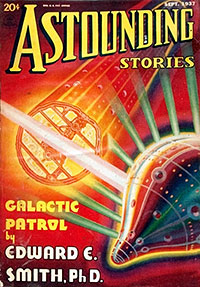 The Lensman series:
The Lensman series:
- “Triplanetary” (1948)
- “First Lensman” (1950)
- “Galactic Patrol” (Astounding Stories, 1937-38)
- “Gray Lensman” (Astounding Science-Fiction, 1939-40)
- “Second Stage Lensmen” (Astounding Science-Fiction, 1941-42)
- “The Vortex Blaster” (aka “Master of the Vortex,” 1960)
- “Children of the Lens” (Astounding Science Fiction, 1947-48)
The Lensman series was originally comprised of volumes 3, 4, 5, and 7. The first book was actually a prior work (published in Amazing Stories in 1934) re-written to fit into the Lensman series, and setup the backstory. The second book was written to create a bridge between the first and the rest. “The Vortex Blaster” is set in the same universe, but is off in a different “area” from the main action. I actually have not read it. Some don’t consider it a proper part of the Lensman series.
The series is a true epic that even extends over a millennium of time. It starts with the alien Arisians, who are the only intelligent race in the universe, and have largely evolved to just contemplate existence. The First and Second Galaxy are about to intersect, and in the process will create a multitude of planets, and the possibility of life and thus intelligent life. The Arisians plan on guiding this new life to create Civilization.
Into this come the Eddorians, a power-hungry and dictatorial race from another reality. They see the emergence of life on these worlds as an opportunity for them to dominate. The Eddorians will do so through a series of lesser races they will control. The two races are evenly matched, so the Arisians seed the new planets and guide several of them to create races who can oppose and defeat the Eddorians. Earth, called Tellus in the series, is one of these worlds.
Triplanetary shows us Earth as its civilization develops through Atlantis, the fall of Rome under Nero, and World Wars I, II, and III until we obtain interstellar drives. This leads to the first interstellar war between the Triplanetary Service and space pirates who are backed by the Eddorians. We also see the lines they have developed on Tellus: one that has the name “Kinnison,” and the other having “red-bronze-auburn hair and gold-flecked, tawny eyes.” Yeah, that second line seems like a nod to Doc Savage. I’ve never heard if that was intended, but others have made use of the connection.
First Lensman tells of the establishment of the Galactic Patrol out of the old Triplanetary Service, when the first Lensman is invited to the Arisian’s homeworld and presented with a special tool: the Lens. This is a disc-like piece of crystal worn like a wrist watch. Only usable by its designated wearer, it enhances mental abilities. From this start, the First Lensman finds and recruits others, including alien Lensmen as well. They fight both crime and corruption, even backing the election of Roderick Kinnison as North American President.
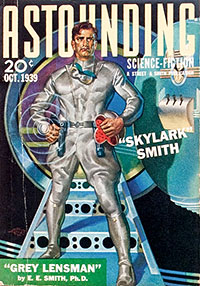 The Lensmen of the “Galactic Patrol”, human and alien, now defend “Civilization” against the Eddorian proxies, the “Boskone.” We then get a range of ever-larger space battles with ever-wilder weaponry. We are also introduced to Kimball Kinnison, who will be the main hero of the next three books and to a lesser extent the final book. This book tells of his training and early career. He is then given the exalted status of “Gray Lensman,” which means he is on detached service with higher authority. During this he meets and plans to marry Nurse Clarissa MacDougall. And she is the result of the other human breeding line.
The Lensmen of the “Galactic Patrol”, human and alien, now defend “Civilization” against the Eddorian proxies, the “Boskone.” We then get a range of ever-larger space battles with ever-wilder weaponry. We are also introduced to Kimball Kinnison, who will be the main hero of the next three books and to a lesser extent the final book. This book tells of his training and early career. He is then given the exalted status of “Gray Lensman,” which means he is on detached service with higher authority. During this he meets and plans to marry Nurse Clarissa MacDougall. And she is the result of the other human breeding line.
In the next work, a group of four Lensmen from different races realize the limitations of their knowledge, and travel to the Arisian homeworld to become “Second Stage Lensmen”. Their abilities are greatly expanded over what it was before. Kinnison is one of these, and Clarissa soon becomes the first female Lensman. The book ends with Kinnison and MacDougall marrying, and the Galactic Patrol in control of the First and Second Galaxy. But the Eddorians are still out there.
In the final book, set 20 years later, Kinnison and MacDougall have produced a boy and two pairs of female twins, the “Children of the Lens” who don’t need the Lens for their mental abilities. They are basically Second-Stage Lensmen and become the first and only Third-Stage Lensmen, and outstrip even the Arisians in mental abilities. But as noted, the Eddorians are still out there. The Children of the Lens team up with the Arisians to destroy the Eddorians. Afterwards, the Arisians remove themselves from reality, leaving the Children as the future guardians of Civilization.
Sequels and adaptions
There were rumors that Smith had in mind a further volume, but no evidence of what this was to be has ever been found.
In 1965, Smith gave permission to William Ellern to continue the series, and he wrote “The Moon Prospector,” “New Lensman” and “Triplanetary Agent.” I’ve never read these.
In 1980, David Kyle wrote three novels about the alien Second-Stage Lensman:
- “The Dragon Lensman” (Worsel, the Velantian)
- “Lensman from Rigel” (Tregonsee, the Rigellian)
- “Z-Lensman” (Nadreck, the Palainian)
There have been Japanese anime adaptions of some of the series, but I have not seen them.
It also should be clear that the Lensman series has influenced other stories and series. A lot of the idea of the Arisians and the Lens are very similar to the Silver Age Green Lanterns and the Guardians of the Galaxy who lead them, though the creators claim no such connection. Whatever. To a degree you see this also in the TV series Babylon 5 as well.
E.E. “Doc” Smith stories are classic science fiction. He wrote more than the above. There is the “Spacehounds of the IPC,” “Galaxy Primes,” the “Subspace” pair, and others.
There are also works based on his, such as the Family D’Alembert and Lord Tedric series. They are fairly easy to obtain in ebook formats and should be checked out. Find out where modern series like “Star Wars,” “Battlestar Galactica,” and others came from.

